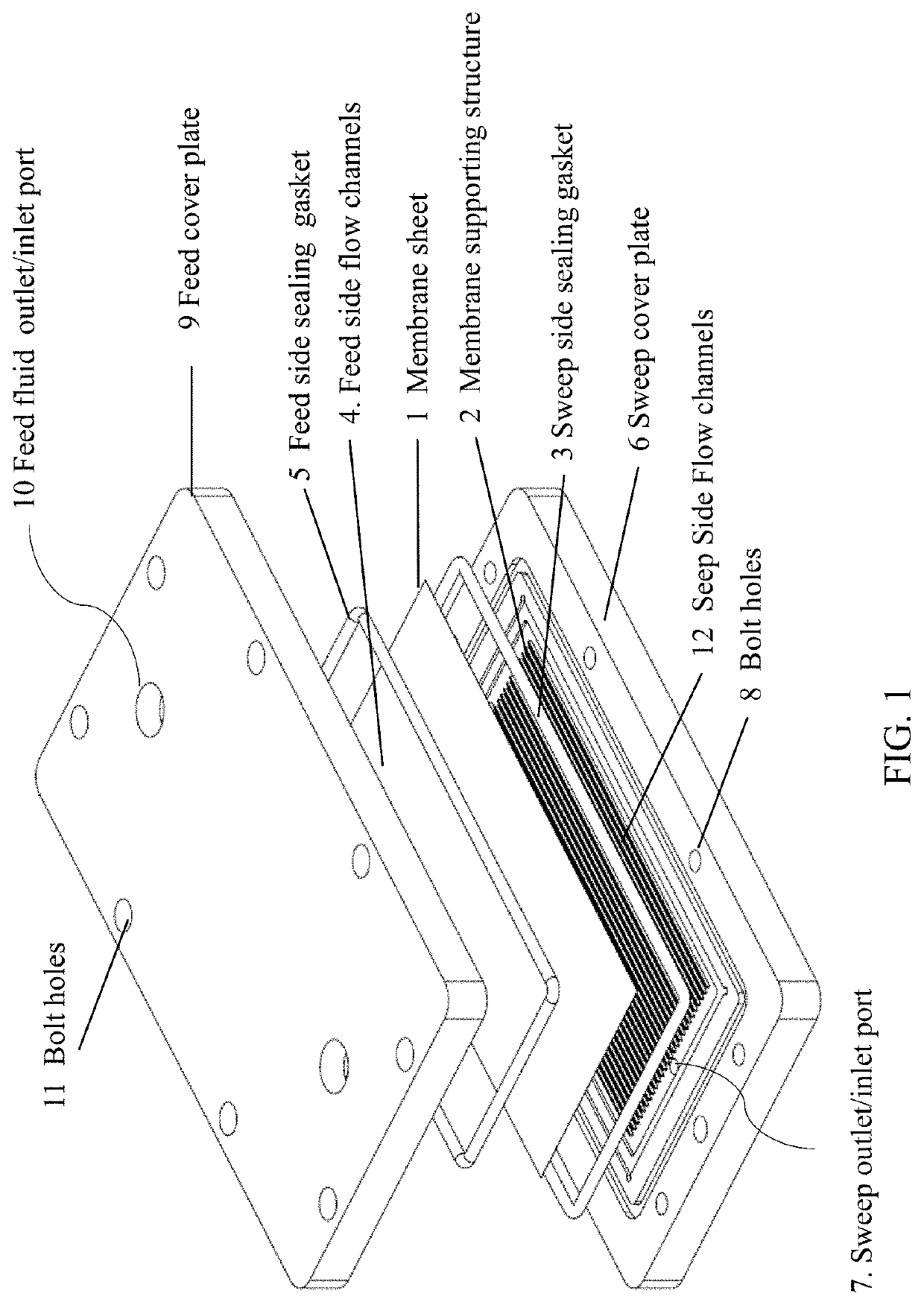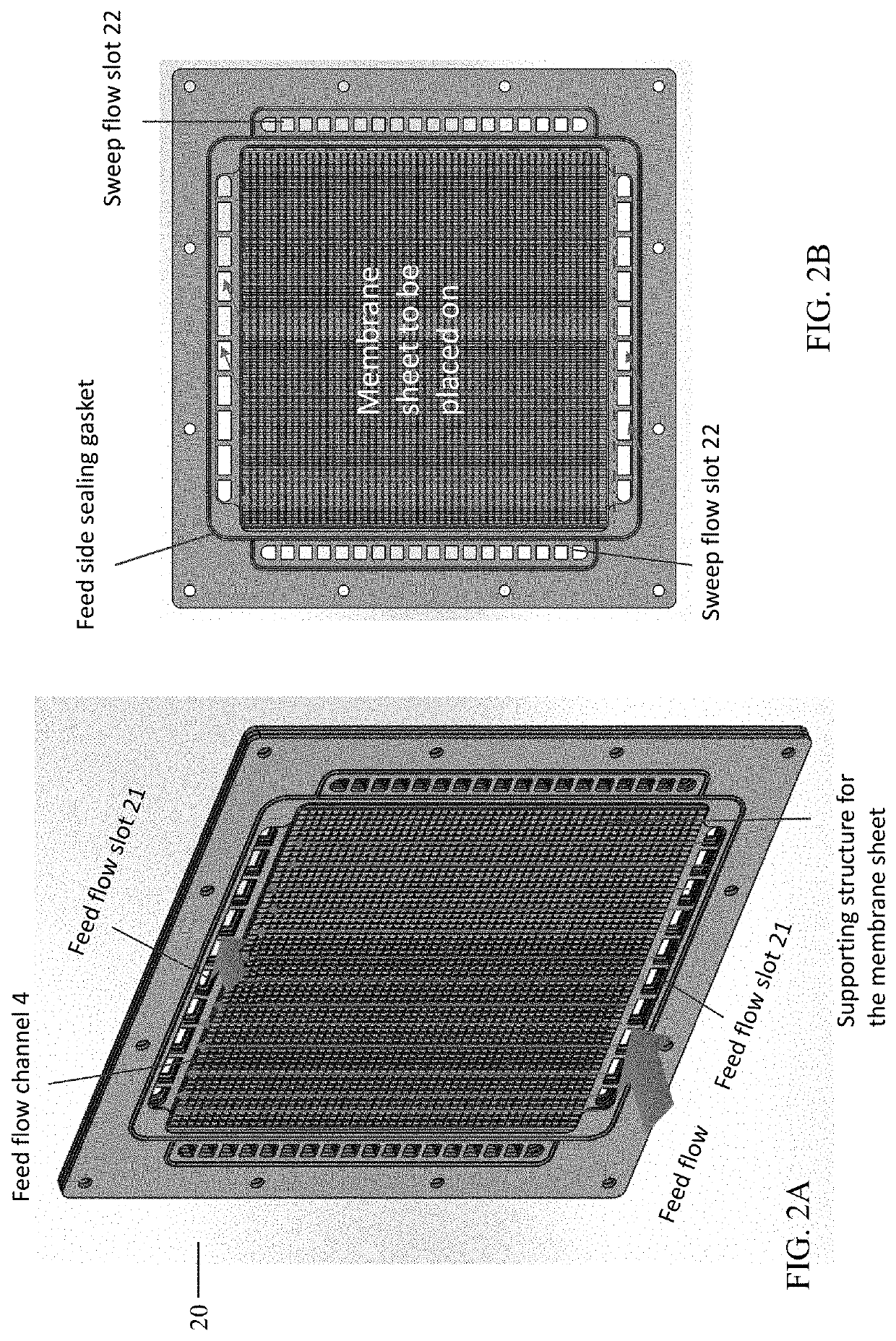Universal Planar Membrane Device for Mass Transfer
a planar membrane and mass transfer technology, applied in the direction of membranes, electrochemical generators, separation processes, etc., can solve the problems of limiting the interchangeability of such cells, system not allowing access to the membrane, and cost of having designated equipment, so as to simplify the manufacture and assembly. , the effect of increasing the processing capacity of the device and achieving the same mass transfer or separation characteristics
- Summary
- Abstract
- Description
- Claims
- Application Information
AI Technical Summary
Benefits of technology
Problems solved by technology
Method used
Image
Examples
example i
n for Online Removal of Fine Particulates from Process Stream
[0061]A device loaded with one membrane sheet 1 (FIG. 9), which is assembled as illustrated in FIG. 1, can be utilized for online filtration of fine particulates from different fluid streams—liquid (water, solvent, or oil, mixtures thereof) and from gases. Typically, any thin flat membrane 1 of 0.05-0.7 mm may be placed within the seating cavity on the sweep cover plate 6 and used depending on the application. In most of the tests shown here, a microporous nickel membrane ˜50 micron thick was used along with a polycarbonate cell 40. In applications involving prolonged exposure to temperatures above 60° C. or depending on chemical compatibility, a completely stainless-steel cell 40 was used. For particulates below 100 nm, YSZ ceramic coated microporous sheet membranes 1 were used. In these cases, the ceramic side is always placed facing the feed side of the cell 40. When used at higher temperatures, the inner silicone feed ...
example ii
xchange
[0068]For humidity and thermal exchange, the polycarbonate version of the device can be used (FIG. 11). It may be placed in any orientation. Ideally, the device should be placed in such a way that any condensation occurring due to high humidity can flow out of the cell 40 easily. The cell 40 may be assembled with a thin NaA zeolite membrane coated microporous nickel sheet. The cell 40 should be assembled such that the zeolite coating is facing the feed side of the cell 40. Humidified process air at different temperatures may be provided from using another cell 40 configured as a humidifier. That application is discussed in detail in Example 3. The humid process air may be flowed through the feed side of the device configured as a humidity and enthalpy exchanger. Humid house air at RH ˜40-50% may be swept through the sweep side at a range of flow rate from 0.5-7.5 NL / min to study the humidity and thermal exchange of the cell 40. Relative humidity (RH) and temperature of the ga...
example iii
midifier
[0069]FIG. 12 shows humidification of process gas using static water. In this example, static water on the feed side is used as the water source. A thin NaA zeolite coated microporous nickel membrane 1 may be used for this application, with the zeolite side always facing the feed. This membrane 1 selectively allows only water vapor permeation. The water for humidification may be fed to the cell 40 using gravity. The feed source may be kept elevated above the lower port of the cell 40. The cell 40 is kept vertically oriented and water enters the cell 40 at the bottom port 10. The water is fed either on the feed side or the sweep side, so it contacts either the zeolite or nickel side. Slight variation in performance is seen depending on the side the liquid water contacts. Care is taken to visually ensure there is no trapped gas on the water side. Gas to be humidified is flowed through the side that does not contain water. The test cell 40 was placed within an oven to maintain ...
PUM
| Property | Measurement | Unit |
|---|---|---|
| hydraulic diameter | aaaaa | aaaaa |
| thick | aaaaa | aaaaa |
| thickness | aaaaa | aaaaa |
Abstract
Description
Claims
Application Information
 Login to View More
Login to View More - R&D
- Intellectual Property
- Life Sciences
- Materials
- Tech Scout
- Unparalleled Data Quality
- Higher Quality Content
- 60% Fewer Hallucinations
Browse by: Latest US Patents, China's latest patents, Technical Efficacy Thesaurus, Application Domain, Technology Topic, Popular Technical Reports.
© 2025 PatSnap. All rights reserved.Legal|Privacy policy|Modern Slavery Act Transparency Statement|Sitemap|About US| Contact US: help@patsnap.com



